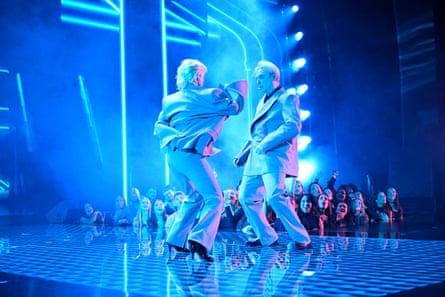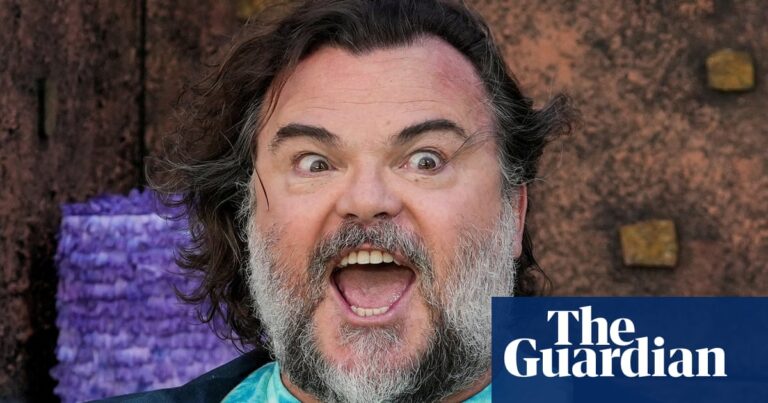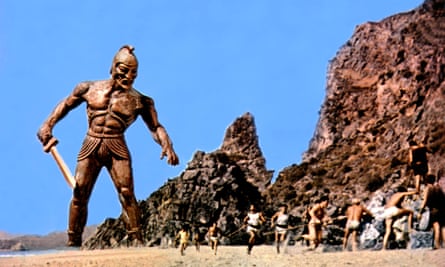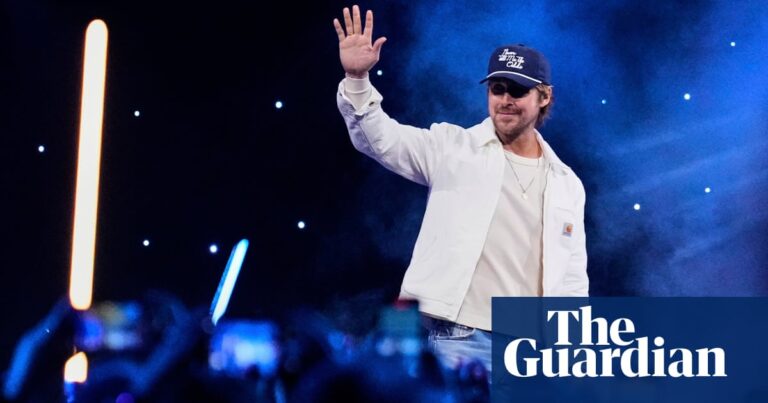As the flirtation first begins to build between CEO Romy (Nicole Kidman) and her twentysomething intern Samuel (Harris Dickinson) in the recent erotic thriller Babygirl, the two find themselves at opposite ends of a dancefloor. Romy pulls away from her husband and stares – pouting – at Samuel, who embraces another woman, a familiar staccato beat pulsing out around them. “I’m in the corner, watching you kiss her,” the lyrics narrate. “I’m right over here, why can’t you see me?” It’s the perfect needle drop, conveying Romy’s desire but also her sense of alienation. Gladly for her, their torrid affair begins nonetheless, and soon the pair are throwing shapes at a sweaty techno rave.
The song that plays is, of course, Dancing on My Own by Robyn, from her Body Talk Pt 1 album, a tune so familiar by now that I felt a Pavlovian urge to start caterwauling along in the cinema. Fifteen years on from its original release in April 2010, the track has established itself as pop’s great modern “sad banger”, in the vein of classics such as Donna Summer’s Last Dance and I Will Survive by Gloria Gaynor. Like those tracks it is a song that gets you up and moving, while breaking your heart into several tiny pieces.
In the years directly after its release, Dancing on My Own was featured on major TV shows such as Lena Dunham’s Girls, and grew in popularity thanks to Calum Scott’s stripped back, Love Island-worthy cover, which peaked at No 2 in the UK charts. These days you can hear it in films, on arena tours (Robyn joined Charli xcx on stage to perform the song during the latter’s Brat tour last year), and on TV (at Saturday Night Live’s 50th anniversary in February, David Byrne and Robyn shared a stage in matching boxy suits for a rendition). It currently ranks at No 20 in Rolling Stone’s list of the 500 greatest songs of all time, sandwiched between Billie Holiday’s Strange Fruit and Imagine by John Lennon.
A lot of songs have staying power but Dancing on My Own stands head and shoulders above so many others from the 2010s (Babygirl would have been a slightly different film had they been dancing to Sexy Bitch by David Guetta). Part of that appeal, says US-based culture podcaster Sam Sanders, is that the song is “the perfect bait and switch”, fusing euphoric music with desolate themes à la disco. “It’s so up-tempo. The percussion is so driving, it sounds like a happy song. And then you hear the lyrics, and it’s not happy at all. It’s really depressing.” The song’s simplicity and repetition, says Sanders, make it “go down easy … you can memorise it right away. By the end of the song, you’re already singing along with the chorus.”
Sanders chose Dancing on My Own as his “American anthem” for a series on NPR back in 2019. As part of his research, he spoke to a musicologist, who informed him that the song’s 117 BPM was almost exactly in line with the average human walking speed. “[Robyn] is doing this in a tempo that is pretty close to the human heartbeat,” Sanders explains. “It’s programmed to burrow into your bones, to get into your body and make you move. It’s inescapable.” While the song wasn’t a smash hit at the time – it didn’t dent the US Top 40, and reached No 8 in the UK – it has become a slow-burn word-of-mouth megahit over the months and years since.
Last September, it topped a poll of Swedish music industry bods’ favourite songs, ahead of tracks by Madonna, Prince and even Abba. Tina Mehrafzoon is a Swedish music journalist who works for P3, the country’s equivalent to Radio 1 and the station responsible for that poll. The song comes with a wider context, says Mehrafzoon: it was from the era directly after Robyn’s departure from Jive Records to form her own label, Konichiwa (at the outset of her career, she had been marketed as a proto-Britney, working with mega-producers such as Max Martin). By this point, Robyn was no longer looking to “conform to some of the ideals that were put on a pop star, while still being the ultimate pop star. She was sort of rewriting what you should look like, what you should sound like. She changed the rulebook, just by being.”

From Lorde’s Melodrama to Taylor Swift’s Reputation via xx member Romy’s melancholy brand of four-on-the-floor, Charli xcx’s direct lyricism, and even Miley Cyrus and Katy Perry lopping their locks into pixie cuts, the charts have seemed impregnated with Robyn’s DNA ever since. For her part, Lorde once wrote that Dancing on My Own is “happy and sad, fiery and independent but vulnerable and small, joyous even when a heart is breaking”. As for the song’s popularity, Mehrafzoon thinks it edged ahead of other singles because of the “credibility” of featuring in US shows such as Girls and Gossip Girl, which have been watched around the world.
In Girls, the song plays when Hannah – played by Dunham – finds out that her boyfriend Elijah is gay. The song fits her situation, and his too; Dancing on My Own has become something of a queer anthem in the years since, with Calum Scott telling the BBC in 2020 that he had first fallen in love with the song while figuring out his sexuality. In a list of LGBTQ+ anthems published online by Billboard, the caption for Dancing on My Own (No 16) reads: “Any gay guy who says he hasn’t related to this synthy jam shouldn’t be trusted.” There is something about watching from afar – the lack of agency or even visibility – that speaks to the queer experience. “I mean, who understands the pain of rejection more than queer people?” says Sanders. “This is all about rejection and dancing through it – that is the queerest reality ever.” He also cites the song’s ambiguous pronouns. “She’s playing with gender. It’s really subtle, but I think where people get that, we saw it and felt it.” There’s also something in the idea of delayed adolescence playing out on a dancefloor; the American academic Jack Halberstam writes that “queer time is the dark nightclub, the perverse turn away from the narrative coherence of adolescence-early-adulthood-marriage-reproduction-death”.
I wondered whether the people who made Dancing on My Own – Robyn, of course, alongside songwriter and producer Patrik Berger, and Niklas Flyckt, who mixed the song – had known they had a hit on their hands at the time. What became clear from speaking to Berger was that this seemingly simple song had, in fact, been a labour of love. “We took weeks on the lyrics, just to really make sure that we nailed every line,” says Berger, who – as well as working with pop stars such as Robyn, Charli and Taylor Swift, also releases experimental instrumentals as Hög Sjö. “We would write, digest, and then be like: ‘Is this really what it feels like when you’re in this situation?’ And then we compressed it to have as much impact in every line [as possible].” Berger says his and Robyn’s Scandi roots shines through, too. Robyn, he says, has “a sort of Swedish way of writing lyrics … she’s very good at actually saying it as it is. We were talking about the fact that – especially if an American artist is singing about a breakup – most of the time, it’s about empowerment: you’re worth better and you’re strong. We were both like: that’s not what it feels like at all! You feel like a loser and an idiot. Maybe that was a little bit new at the time …”
after newsletter promotion

For Flyckt, he says it stood out instantly when Berger first played it to him. “It’s an amazing song, so it was sounding great as a demo; most of it was pretty much there,” he says. “I tried to add some kind of boldness, just starting with the bass riff and no melody in the beginning.”
There’s an irony to Dancing on My Own that is hard to avoid. It’s a song about being all by yourself, but it’s a communal experience. It’s a song that Robyn’s fans sing back to her on stage when the music cuts; that fans have gathered to sing on train platforms after shows; that choirs and a cappella groups now cover in epic new arrangements. For Berger, feeling like we’re alone “is probably the most uniting thing that we have as humans: it is something that we all understand, but that we don’t really talk about all the time.” Being alone together comforts people, he says, but he still hasn’t got used to seeing it at scale. “When [Robyn] performs live and she strips down the music and the whole arena sings … it’s mind-boggling to me. I’m like: wow, everybody can relate to this thing. I feel very emotional.” Perhaps it speaks to the current moment. We’re more connected than ever but, in many ways, more distant; a piece published by the Atlantic earlier this year called this “the antisocial century”.
Whatever it is about this song that makes people stop what they’re doing and sing along, it doesn’t seem as if it’s going away any time soon. Berger says he hears the track more and more, stuffed into acoustic open-mic sets in bars next to the likes of the Beatles. Robyn has gone on to release another excellent album, Honey, in the intervening years, but there’s something about her “sad banger” that just won’t fade away. Says Sanders: “You could hear the song on the dancefloor in 2050 and folks would be like: ‘I want to dance.’”
Source: theguardian.com





















